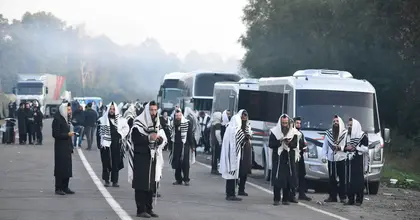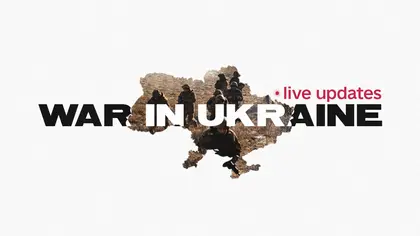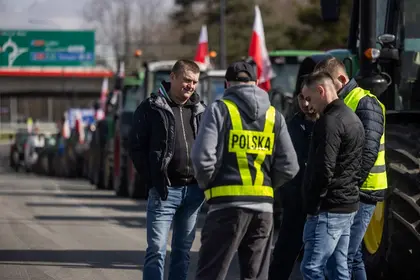Autumn is here and, despite the ongoing war, Hasidic pilgrims from all over the world are arriving in Ukraine to honor one of the founders of the Hasidic movement.
Every year in September the population of the town of Uman in Cherkasy region (190 km south of Kyiv), quadruples as Hasidic Jews pour in to celebrate Rosh Hashanah, the Jewish New Year.
They make the pilgrimage to Uman because one of the founding fathers of Hasidism, Rabbi Nachman of Bratslav, is buried there. He died there in 1810 and, in line with his request, was buried in the local Jewish cemetery next to the graves of the victims of the Haidamak massacre of 1768.
Had Rabbi Nachman not insisted on being buried in Uman, his ashes would have been transported to Jerusalem and today Uman would be an ordinary, quiet provincial town. As it is, the city has long been Ukraine’s main center of religious tourism and a significant industry has developed around the celebration of the Jewish New Year involving transportation, real estate, rental accommodation, and kosher cuisine. Many Hasidim have purchased real estate in Uman and are involved in the rental business themselves.
Quite a party
Before the war, dozens of charter flights from Israel and the United States flew into Kyiv at this time of year, and lines of specially booked buses and cars could be seen waiting at the airport to whisk the pilgrims off south to Uman.
The celebration can last over a month and security has always been an issue. In cooperation with the Ukrainian police, Israeli police officers used to fly to Ukraine specifically to monitor the behavior of their fellow citizens. Local police also carefully patrolled the streets trying to make sure that conflicts did not break out between residents and visitors. Nonetheless, every year some small conflicts arose: It was almost unavoidable. After all, the Hasidim celebrate with a great deal of energy and noise, singing songs and dancing every night.
They obviously like Uman and feel at home there, despite the tragic history of past centuries and the memory of the pogroms which are, indirectly, the reason for their coming.
Ignoring calls to stay away this year
This year, in view of the war, the Ukrainian and Israeli authorities warned the Hasidim well in advance to cancel the celebration of Rosh Hashanah in Uman. The threat of rocket attacks is very real and there has been no civil aviation in Ukraine since the start of the war so it’s not possible to fly to Kyiv.
However, the borders in the West of the country are open, and trains and buses are running. Already the first thousand Hasidim have reached Uman, on buses. The international Flix bus company has introduced some new routes such as Krakow-Uman, Prague-Uman, and Brno-Uman.
In response to warnings about the danger, representatives of the Hasidim said that life in Israel is constantly fraught with the danger of terrorism, so they see no reason to change their traditions because of the war in Ukraine.
Part of the local community
While Hasidim from Israel, New York, and elsewhere make their way to Uman, there are Hasidim who live in Uman permanently. They remember the early days of the war when Russian missiles fell on the city and nearby villages.
At the beginning of the war, the number of Hasidim living in Uman increased, with many coming to help the local Jewish community as well as the non-Jewish population, both locals and refugees. A Jewish charity kitchen was set up in Uman which feeds everyone who needs to be fed.
In late February and early March, many people were wounded and killed in Uman as a result of shelling and local Hasidim opened the basement of the synagogue for use as a bomb shelter.
Russian threats
The Russian Ministry of Defense announced that the Hasidim had given the synagogue to the Ukrainian army for an arms depot.
“The property of the Jewish cult in Uman is deliberately being used by Kyiv’s nationalist regime for military purposes.” said Russian Defense Ministry spokesman, Igor Konashenkov.
At the end of March, there was a real possibility that Russia would try to destroy the synagogue with rockets.
In response, the leaders of the Hasidic movement in Uman recorded a video showing the empty premises of the synagogue and other religious buildings and declared the words of the representative of the Russian Ministry of Defense to be a lie. Fortunately, no Hasidic shrines in Uman were damaged during Russian shelling.
Fewer pilgrims mean fewer tourists
Traditionally, some pilgrims have remained in Ukraine after the celebration of the Jewish New Year to visit other places connected with the history of Ukrainian Jews – old shtetls in the Vinnytsia region closer to Moldova,.
The local authorities in Uman are still hoping that there will be fewer pilgrims this year. If their attempts to dissuade people from coming are successful, the other tourist destinations usually visited by the pilgrims will suffer, for example, Shargorod in Vinnytsa region (347 km southwest of Kyiv), where many Jewish historical monuments were restored to good order before the war, including the oldest synagogue in Ukraine – built in the 16th century.
Even under Soviet rule, until WW II, Shargorod was an almost entirely Jewish town with a population of about 10,000 people. Now, with the same population, only a dozen Jews live in the city, but the townspeople protect the historical heritage and hope very much that tourism will sooner or later bring some money to the town. This year, that is almost certainly not going to happen.
You can also highlight the text and press Ctrl + Enter






Comments (0)